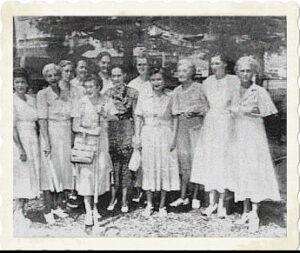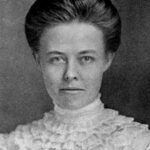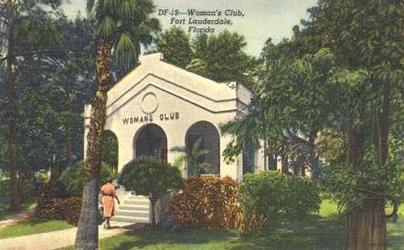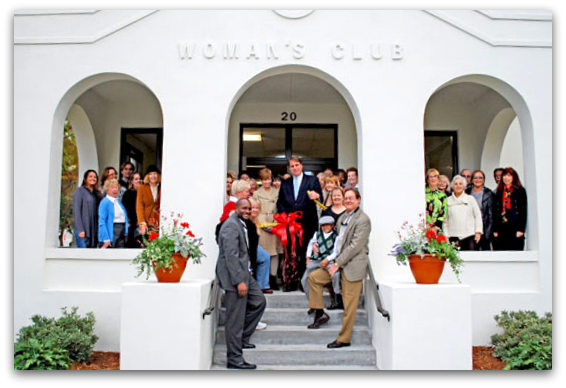 The Fort Lauderdale Woman’s Club was founded on January 11, 1911 with 18 members by the Board of Trade. We were first called the Woman’s Civic Improvement Association. The club predated the incorporation of the city itself by two and a half months.
The Fort Lauderdale Woman’s Club was founded on January 11, 1911 with 18 members by the Board of Trade. We were first called the Woman’s Civic Improvement Association. The club predated the incorporation of the city itself by two and a half months.
The club was federated by the GFWC in 1912 and on November 28, 1913, the name of the club was changed to the Fort Lauderdale Woman’s Club. Much of the history of the city is intertwined with the history of the Woman’s club. In 1912 club was instrumental in starting a volunteer fire department, donating $100 for their use. In 1913, club members got out the newspaper for vacationing publishers.
 Among our proudest achievements is in the area of humanitarian concerns. When Ivy Stranahan, the “Mother of Fort Lauderdale,” was our president (1913-1916), she worked through the Florida Federation Of Women’s Clubs (FFWC), to advance the rights of all women and of Native Americans and African Americans. As chairperson of Indian Affairs for the FFWC Ivy had the support of the FLWC in helping to secure Seminole Reservations in the state of Florida.
Among our proudest achievements is in the area of humanitarian concerns. When Ivy Stranahan, the “Mother of Fort Lauderdale,” was our president (1913-1916), she worked through the Florida Federation Of Women’s Clubs (FFWC), to advance the rights of all women and of Native Americans and African Americans. As chairperson of Indian Affairs for the FFWC Ivy had the support of the FLWC in helping to secure Seminole Reservations in the state of Florida.
Also, Ivy and her husband, Frank Stranahan, donated land for a school for African Americans and Ivy served as treasurer of Provident Hospital, the first hospital to serve the medical needs of Fort Lauderdale’s black citizens.
In 1916, Ivy and Frank Stranahan donated a 135 x 100 lot to build our clubhouse, which was designed by the acclaimed architect August Geiger in the Mediterranean Revival Style. The building was dedicated in May 1917.
In 1917, members began gathering books, housing them in members’ homes. By 1925 the club turned over a collection of 1200 books to the city to begin today’s public library system.
In the 1920s a stock and poultry ordinance to keep livestock off the streets was secured. In 1924 we started an Educational Loan Fund for students to borrow money for education; later the scholarships were given with no restrictions on repayment. We assisted the County Commissioners in securing a comfortable home for the aged called “Haven of Rest” in Dania. Residents were asked to submit a name for the Fort Lauderdale’s large port and our club recommended the name “Port Everglades” which was chosen and now known worldwide.
Annie Beck, president in 1924-25, was instrumental in the restoration of devastated Fort Lauderdale after the 1926 hurricane whereas our clubhouse served as an emergency shelter. Founding member of the city’s garden club, Annie planted a yellow trumpet tree (Tabebuia Caraiba) at her landmark home in 1939. A small memorial park in her name, planted in Tabebulias, can be found along Victoria Park Road. Her home, floated down New River to preserve its 20th century bungalow architecture, is today at Middle River Terrace City Park.
In April 1926 the city’s first planner, nationally known Richard Schermerhorn Jr., set up a meeting in the Woman’s club to begin planning the city, which was booming at this time. His plan included renaming the streets and avenues with the clubhouse at the focal point at the corner of Andrews Avenue and Broward Blvd. Members also started the first Girl Scout Troop and a Needlework Guild and helped plant the royal palms on Las Olas Boulevard.
As years went by it was the first Red Cross headquarters and was used as a servicemen’s canteen during World War II. Members sold so many war bonds that a plane was named in the club’s honor. In the 1940’s during WWII, our members sold so many War Bonds that a pursuit plane was named the “Fort Lauderdale Woman’s Club.”
An antique show, started in 1946, attracted dealers from throughout the United States; it was replaced with a mini-bazaar when competition and parking became a problem. In 1949 the front entrance was changed from Andrews Avenue to S.E. First Street. The clubhouse was remodeled with much of the labor and materials donated, our cost was $22,650. In 1951 an air conditioner was installed making us the first Woman’s club in the State of Florida to provide this comfort. In 1953 a ceremony was held for the “burning” of the mortgage on our clubhouse. We raised money for the building fund of Holy Cross Hospital and also helped with monies for dredging the New River. An Allied Youth Post was started by members and continued for many years.
 In 1969 Virginia Young, president 1944-46, was elected city commissioner and then mayor of Fort Lauderdale. The daughter of a tugboat captain, Virginia served on the school board and so far, the only female mayor. She was a staunch supporter and member of the city’s Downtown Development Authority, fighting for the preservation of historic buildings.
In 1969 Virginia Young, president 1944-46, was elected city commissioner and then mayor of Fort Lauderdale. The daughter of a tugboat captain, Virginia served on the school board and so far, the only female mayor. She was a staunch supporter and member of the city’s Downtown Development Authority, fighting for the preservation of historic buildings.
During the 1970s, the club became charter members of Broward County Pioneer Days and also a charter member of Special Olympics of Broward County, which was founded to help mentally and physically challenged individuals find a more productive life.
In October 1982 our clubhouse was the first place winner in the city’s coveted Community Appearance Award. We sold 23 feet of our land to the city for the widening of Andrews Avenue. This money was used to renovate the building by adding a ramp for the handicapped, installing paddle fans, painting, building new front steps and adding double front doors. The entrance hall floor was raised, eliminating a step for security reasons; the restrooms and the kitchen were updated to include a new dishwasher.
Throughout the late 1980s and 1990s, club membership decreased as older members moved away or into retirement homes or became too frail to participate in club functions to the extent that they once had done. Also as Broward County expanded to the west and north, women decided to join clubs closer to their homes in Plantation, Davie, Coral Springs and Parkland. In lieu of membership dues our main source of income was from the rental of our clubhouse for parties, weddings, church and music groups. We still supported state and national charities such as Hacienda Ranch for Girls, Canine Companions for Independence and the Special Olympics, as well as local causes such as the Jack and Jill Day Care Center and the annual Broward County Pioneer Days.
As 2000 rolled around our main thrust became the push to get historical designation for our clubhouse so we could qualify for grants to restore it to its original beauty. We came close in 2001 but ripples from the events of 9/11 slowed our progress. Compared to years past when communications could only be delivered in person or by telephone, our members now received information via email and the Intranet. In 2007-2009 Alice Sakhnovsky made history as the first African American president. By the year 2010 club membership totaled 116.
On January 11, 2011 we celebrated our 100th birthday. Our members no longer consist of city pioneers, but are still keenly interested in making a recognizable difference in the educational, cultural and humanitarian needs of the community and beyond. More importantly shortly after our birthday celebration, a ribbon cutting ceremony was held with Mayor Jack Seiler, Vice Mayor Romney Rogers, Commissioner Bobby DuBose and many club members in attendance on the newly renovated porch.
Architect Susan McClellan, Louis Friend of Friendly Construction and Building Chair Eugenia Duncan Ellis proudly presented the completion of the Phase 1 renovations, which returned the building location to its original orientation and street address to 20 South Andrews Avenue.
Today, our clubhouse has received historic designation. We continue to work tirelessly to preserve this most significant building in the heart of downtown Fort Lauderdale. Now over 100 years of age, the Fort Lauderdale Woman’s Club continues their many missions, giving back to the community with a tag line of “a century of citizenship.”


